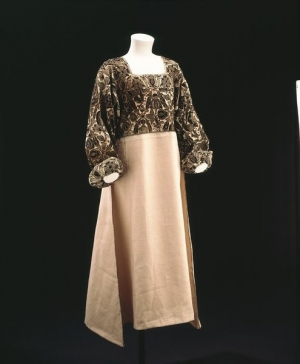A smock was usually of thigh length for men and longer for women. From the thirteenth century onwards, fashionable smocks were often made of fine linen and embroidered with gold thread or coloured silks. Other fabrics used for smocks included cambric, Holland, lockeram or occasionally silk.
In Western Europe during the sixteenth and seventeenth centuries, the term smock was applied to a decorated undergarment worn by women from wealthy families. The accompanying illustration shows an English smock top in linen (the lower half was added later) with embroidery in silk blackwork. It dates to c. 1580 (Victoria and Albert Museum, acc. no. T.113 to 118-1997). It is an undergarment, in the sense that it was worn under the outermost items of dress, but it was never intended to be concealed completely.
Decorated smocks were sometimes worn as semi-formal wear in bed, for receiving visitors. Such smocks were often made of two different grades of linen. A fine-weave linen was used for the bodice and sleeves, while a coarser one was employed for the skirt. The finer and more expensive linen was thus only used for areas of the garment that could be seen by visitors.
In some modern descriptions of medieval and later European paintings, a woman’s partlet is misidentified as a smock, but these are not identical garments. By the nineteenth century the term smock was regarded as obsolete, as the French term chemise had been adopted.
Sources:
- CAULFEILD, Sophia Frances Anne and Blanche C. SAWARD (1882). The Dictionary of Needlework, London: L. Upcott Gill, p. 453.
- CUMMING, Valerie, C.W. CUNNINGTON and P.E. CUNNINGTON (2010). The Dictionary of Fashion History, London: Bloomsbury Academics, p. 190.
- Shorter Oxford English Dictionary: ‘Smock’.
V&A online catalogue (retrieved 8th July 2016).
GVE

